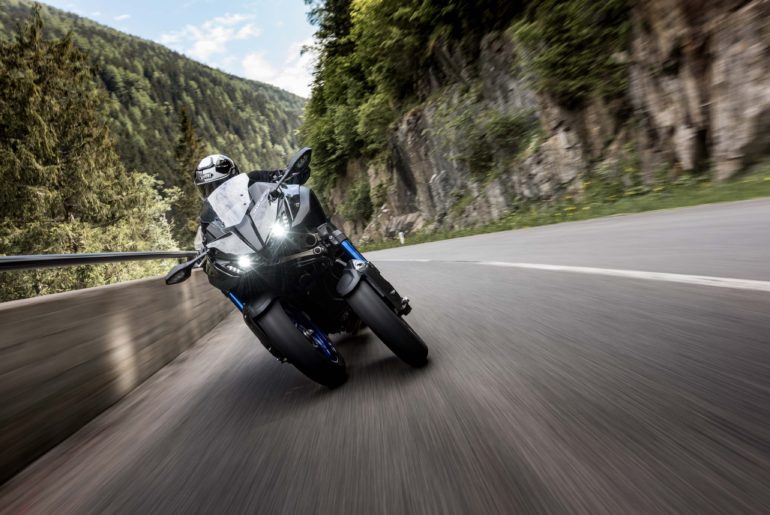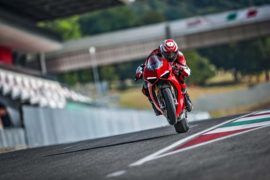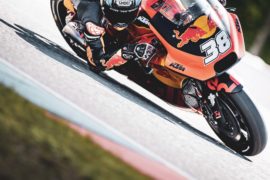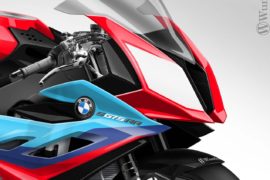“Ride the Revolution.” That’s Yamaha’s tag line for its latest sci-fi powersport creation— the three-wheel equipped NIKEN.
But the NIKEN is more than just a Transformer-esque motorcycle equipped with an extra wheel, instead, its engineered specifically to increase cornering grip, while maintaining an authentic leaning experience that only a motorcycle can provide.
Easier said than done, right? Well, after spending a day riding high in the Austrian Alps, we can see merit in Yamaha’s latest production concept.
Why Three Wheels?
Yamaha says that the NIKEN was a result of a simple goal: “the target was to make a motorcycle with more grip, so it can corner better,” says Yamaha Motor Europe’s product planning manager, Leon Oosterhof.
“The target was not to have a three-wheeler,” he continues to reveal. “We need two [front] wheels, but it also needs to lean like a motorcycle. Once the solution was set, and we decided ‘we definitely need an extra front wheel,’ the LMW plan was created.”
At the heart of the NIKEN front-end is a new parallelogram linkage. The hardware is mounted out of sight, above the 15-inch cast alloy wheels and is responsible for controlling the lean of the front suspension.
A set of KYB inverted forks are mounted externally, outside the wheels, which allows for greater lean angles (up to 45-degrees says Yamaha) and suspension articulation.
The front fork leg (41mm) is responsible for guidance and direction setting, maintaining a constant wheel track of 16.14 inches. Legally, that classifies the NIKEN as a motorcycle says Yamaha.
Inside the front fork, there’s only oil, with spring and damping duties handled by the larger 43mm diameter rear legs. It includes independent compression and rebound damping allowing the rider to tweak the 4.33 inches of suspension movement.
In an effort to provide the most natural steering possible, a steering tie rod is mounted in front of the rigid parallelogram linkage.
It operates through an offset steering knuckle so engineers could separate lean and steering duties. The setup incorporates “Ackermann” steering geometry, so the inner wheel follows a tighter radius than the outer to ensure that the outer wheel doesn’t slip or scrub at speed.
Due to the extremely unique (and rigid) design of the front suspension, a new frame was fitted to provide just the right amount of flex.
“We needed to have a dedicated frame to be in alignment with the chassis,” Oosterhof says. “The frame is made from a mix of materials – partly aluminum, but also steel. We did this to reach an optimized flex because the front end is so rigid.”
As he mentions, the frame is a hybrid configuration composed of a reinforced cast steel head stock. It mounts to a tubular steel main frame and an aluminum swingarm mount.
On paper the setup appears similar to Aprilia’s Dorsoduro chassis. A conventional-looking cast alloy swingarm stretches wheelbase to 59.4 inches (0.4 in. longer than the Tracer 900 GT). Rear suspension is handled by a linkage-equipped KYB shock with remote preload and rebound damping adjustability.
What’s it Like to Ride?
Despite sharing similar length and wheelbase measurements to the Tracer 900, swinging a leg over the NIKEN reveals a substantially wider machine, at least compared to an MT-09.
Still it employs a very much upright seating position, the ergonomics are more relaxed and the riding position has shifted rearward by two inches. This also helped Yamaha achieve a nearly 50/50 weight distribution.
On the scale, the NIKEN weighs in at 580 pounds, with its 4.8-gallon tank topped off. That’s 155 pounds more than the MT-09, which you’ll feel when lifting it off its side stand.
It is worth noting that the NIKEN doesn’t self-balance, requiring a reasonable, but albeit lesser degree of natural balance to ride.
In spite of its extra heft, pulling away from the parking lot reveals a surprisingly lithe machine. The immediate torque of Yamaha’s 847cc three-cylinder engine (along with lower final drive gearing) make for easy launches from a stop.
Right from the get-go, the NIKEN feels well, like a motorcycle. Steering effort, even at low speeds, is no heavier feeling than its two-wheeled counter part. Sure, it does take up a bit more lane real estate than a bike, but it isn’t by much.
The NIKEN glides down roads offering a remarkable level of comfort. The suspension does a fine job of filtering road imperfections with each side functioning independently of one another— this was a big deal for Yamaha, and it is neat to feel it work in action.
Contrary to a traditional sport motorcycle, trail braking (with the front brakes) isn’t as crucial during corner entry. Instead the NIKEN’s front suspension naturally collapses, pressing down on the adventure-touring spec Bridgestone Battlax A41 tires into the pavement.
Aside from the vague road/tire feel, the action of the front suspension is downright excellent with a planted feel.
Curiously, Yamaha chose to fit adventure-touring spec rubber, instead of Bridgestone’s T31 sport-touring hoops. Why? Yamaha PR men weren’t exactly sure. Nevertheless, these shoes grip well allowing you to explore the NIKEN’s high level of cornering potential.
Because of the front end’s muted feel, as compared to a modern sport motorcycle, for some (author included), it will take some time to gain confidence in the machine.
Tip: let the foot peg feelers be your gauge. If sparks fly off them, you’re doing it right. If not, lean it over more!
The harder you lean on the NIKEN’s front-end, the better it performs, regardless if the tires are up to operating temperature or not. This was readily evident through one particular photo stop on a cool mountain road, after a lengthy break.
This will no doubt be a big plus for those that ride in chilly and/or inclement conditions.
Yamaha’s traction control system carries over, offering two-levels of intervention.
The system can also be manually disabled at a stop – say if you feel the urge to pull a wheelie away from an intersection. A word of caution: although requiring a bit of help at first, once the front end rises quick. Cover that rear brake!
Ham-fisted riders may notice extra movement from the back of the bike—especially when loaded during hard acceleration, but it’s nothing that the addition of rebound damping can’t tune out.
Yamaha’s D-Mode combined throttle/engine mapping software is also standard. As with other Yamaha sport motorcycles we preferred the overall feel of Level 2 (normal response).
Those looking for a more aggressive throttle feel will likely appreciate Level 1. Of course, if you are new to NIKEN or want the most gentle power delivery possible Level 3 would be a suitable option.
Aside from the two-tooth larger rear sprocket, and modified crankshaft (with thicker webs) amounting to 18% more crankshaft inertia, the three-cylinder engine is essentially the same as it is in Yamaha’s two-wheel line-up…not a bad thing.
Even in oxygen deprived mountain elevation, the engine delivers a pleasing amount of acceleration—especially in the lower three gears.
An electronic quick-shifter further boosts the feeling of acceleration— allowing the rider to upshift into the next cog under full throttle. Downshifts however still have to be made the old-fashioned way, with the clutch.
The engine’s smooth, vibration free demeanor lends itself well to distance riding. I also love the song it plays when you’re rushing through the gearbox.
Still, I would be remiss if I didn’t say that I desire just a bit more power. Considering the extra heft (and drag) the three-cylinder engine works harder than it probably should. I wonder what the NIKEN would be like with the YZF-R1’s crossplane inline-four…
Cruise control further elevates comfort on the open road, as does a supportive saddle that left us wanting to ride beyond our 183-mile test loop in the Austrian Alps.
However I wish Yamaha would have fitted a more sizable windscreen to better deflect air off the rider’s chest.
After all, the Tuning Fork brand positions the NIKEN as a premium offering that splits the difference between the sport and touring segments. To be fair however, the width of the NIKEN’s face does admirable job of keeping the rider’s lower body out of the elements.
ABS-equipped hydraulic triple-disc brakes keep speed in check and do a fine job of hauling the nearly 600-pound NIKEN down from speed.
Brake feel could be a tad better, and considering its premium positioning, it would have been nice if Yamaha outfitted it with a heavier-duty radial front brake master cylinder.
The Final Word
This bring us to price. Yamaha Motor US still hasn’t announced official pricing, but it says to expect a price of right around $16,000— roughly 77% more than an 2018 Yamaha MT-09.
Yet, Yamaha feels confident that the NIKEN will appeal to a more affluent and experienced motorcyclist— one desiring a flashy machine, unlike anything else on the road.
Which leads me to the big question: would we buy a new NIKEN? Probably not. I still prefer the lightness, maneuverability and overall size of a conventional two-wheeler.
So for my money, I’d go with the Tracer or MT. Still, I can’t deny the NIKEN’s fun factor, nor its astounding level of engineering that magically allows a three-wheeled vehicle to literally deliver an authentic sport riding motorcycle experience. Well done, Yamaha.










































